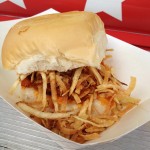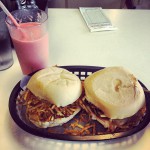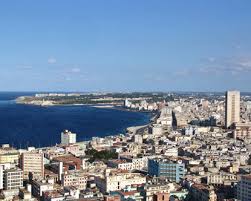There are no doubts that the big “fritero” was Sebastián Carro Seijido. Aristocratizó the fried one. He used only the best products. It taught its personnel to work with cleanliness and, especially, they were required, in its dealing with the clients, to give samples of an exquisite courteousness, and it got into debt in gaining itself to the feminine clientele because it was this the one that was dragging the children and the whole family. So much there prospered Sebastián Carro who at the end of the 50s was giving himself the luxury of promising to be in the exclusive Book of Gold of the Society Of Havana.
Who was Sebastián? Today, many years after its death, it turned out to be easy to continue the steps to him thanks to the collaboration of Juan Pablo Fernández Bravo, man of prodigious memory despite its 82 years to us and whom they all, in the share-out Santa Amalia, meet for Panchito.
It worked up to its retirement like captain of the restaurants of the Hotel Riviera, but earlier, and after Daughters of Gallicia practised like clerk in the coffee, near to clinic of this name, and in the restaurant El Escorial, house of Spanish meals of Marina and San Lázaro, industrial associate of Sebastián was, that is to say, someone who joins to a business and shares its profit, but that does not contribute capital; its work only.
FOLLOWING THE FOODSTEPS
The Galician immigration was big in Cuba during the first decades of the XXth century. The women, who often could neither read nor write, were placing themselves like servants, while the men were employed at what was appearing before them. Sebastián Carro was one of those so many Galicians for that he looked and found a better life in the Island. He was a coalman, but when the gas begun to be imposed like domestic fuel in the district he noticed that had to penetrate into another draft. It put then a position of fried in the shallows of its house, in Shoe and A, but from there it was extracted by the decree of the president Grau who was prohibiting the sale in the portals. The owner of the Walk Club, restaurant – bar of Walk and Shoe, him united on having transferred, with sight to the street Shoe, a small space in its establishment. Its fried ones already had reputation and the clients’ inflow was becoming every time major.
Sebastián, although it was provided with the help of its wife and of two employees, scarcely was giving to pack-saddle. The Boulevard opened then the snack bar, in 23 in two and Four, and it took associate’s Panchito. The business progressed more and it inaugurated another snack bar in the street I walk, opposite to the ancient Palace of the Sports, which then Sebastián called himself and the current one is The Camp stove. When the Revolution triumphed, its plans were those of expanding towards the Ayestarán area.
The State, in “negotiations” with the owner with posteriority 1959, “acquired” The Boulevard, and Panchito was supported like manager until 1965, when it went on to the Hotel Riviera. Néstor, one of Sebastián’s children, stayed at the head of the business of Shoe and Walk, but it turned it into a small restaurant. Other of its children, Iván, ended up by delivering voluntarily The Camp stove to Gastronomy. Sebastián Carro Seijido died in Havana, possibly in the 70s.
UP TODAY “THE FRITA CUBANA” (MIAMI, FLORIDA)
Sources: CiroBianchiRoss/InternetPhotos/www.thecubanhistory.com
“La Frita King” en la Havana * El Rey de la Frita en la Habana.
The Cuban History, Arnoldo Varona, Editor
EL REY DE LA FRITA EN LA HABANA
No hay dudas de que el gran fritero fue Sebastián Carro Seijido. Aristocratizó la frita. Empleó solo los mejores productos. Enseñó a sus empleados a trabajar con limpieza y, sobre todo, les exigió que, en su trato con los clientes, dieran muestras de una cortesía exquisita, y se empeñó en ganarse a la clientela femenina porque era esta la que arrastraba a los niños y a toda la familia. Tanto prosperó Sebastián Carro que a fines de los años 50 se daba el lujo de anunciarse en el exclusivo Libro de Oro de la Sociedad Habanera.
¿Quién fue Sebastián? Hoy, muchos años después de su fallecimiento, nos resultó fácil seguirle los pasos gracias a la colaboración de Juan Pablo Fernández Bravo, hombre de memoria prodigiosa pese a sus 82 años y a quien todos, en el reparto Santa Amalia, conocen por Panchito.
Trabajó hasta su jubilación como capitán de los restaurantes del Hotel Riviera, pero antes, y luego de ejercer como dependiente en el café Hijas de Galicia, cercano a clínica de ese nombre, y en el restaurante El Escorial, casa de comidas españolas de Marina y San Lázaro, fue socio industrial de Sebastián, es decir, alguien que se incorpora a un negocio y comparte sus ganancias, pero que no aporta capital; solo su trabajo.
TRAS LAS HUELLAS
La inmigración gallega fue grande en Cuba durante las primeras décadas del siglo XX. Las mujeres, que a menudo no sabían leer ni escribir, se colocaban como sirvientas, en tanto que los hombres trabajaban en lo que se les presentaba. Sebastián Carro fue uno de aquellos tantos gallegos que buscó y encontró una vida mejor en la Isla. Fue carbonero, pero cuando el gas comenzó a imponerse como combustible doméstico en la barriada se percató de que debía incursionar en otro giro. Puso entonces un puesto de fritas en los bajos de su casa, en Zapata y A, pero de allí lo sacó el decreto del presidente Grau que prohibía la venta en los portales. El propietario del Paseo Club, restaurante-bar de Paseo y Zapata, le dio la mano al cederle, con vista a la calle Zapata, un pequeño espacio en su establecimiento. Ya sus fritas tenían fama y la afluencia de clientes fue haciéndose cada vez mayor.
Sebastián, pese a que contaba con la ayuda de su esposa y de dos empleados, apenas daba a basto. Abrió entonces la cafetería El Bulevar, en 23 entre Dos y Cuatro, y llevó a Panchito de socio. Progresó más el negocio e inauguró otra cafetería en la calle Paseo, frente al antiguo Palacio de los Deportes, que entonces se llamó Sebastián y es la actual La Cocinita. Cuando triunfó la Revolución, sus planes eran los de expandirse hacia la zona de Ayestarán.
El Estado, en “negociaciones” con el propietario con posterioridad a 1959, “adquirió” El Bulevar, y Panchito se mantuvo como encargado hasta 1965, cuando pasó al Hotel Riviera. Néstor, uno de los hijos de Sebastián, quedó al frente del negocio de Zapata y Paseo, pero lo convirtió en una fonda. Otro de sus hijos, Iván, terminó entregando voluntariamente La Cocinita a Gastronomía. Sebastián Carro Seijido falleció en La Habana, presumiblemente en los años 70.
HASTA HOY “LA FRITA CUBANA” (MIAMI, FLORIDA)
Sources: CiroBianchiRoss/InternetPhotos/www.thecubanhistory.com
“La Frita King” en la Havana * El Rey de la Frita en la Habana.
The Cuban History, Arnoldo Varona, Editor





